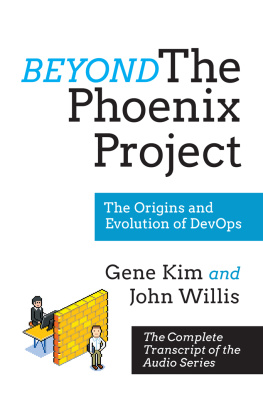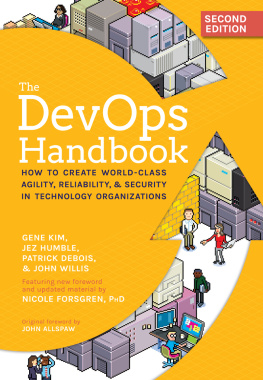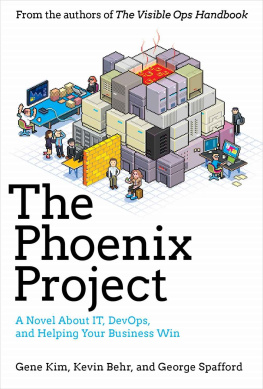Guide to
Gene Kims & et al
The Phoenix Project
A Novel About IT, DevOps, and Helping Your Business Win
by
Instaread
Please Note
This is a companion to the original book.
Copyright 2016 by Instaread. All rights reserved worldwide. No part of this publication may be reproduced or transmitted in any form without the prior written consent of the publisher.
Limit of Liability/Disclaimer of Warranty: The publisher and author make no representations or warranties with respect to the accuracy or completeness of these contents and disclaim all warranties such as warranties of fitness for a particular purpose. The author or publisher is not liable for any damages whatsoever. The fact that an individual or organization is referred to in this document as a citation or source of information does not imply that the author or publisher endorses the information that the individual or organization provided. This concise companion is unofficial and is not authorized, approved, licensed, or endorsed by the original books author or publisher.
Table of Contents
Overview
The Phoenix Project is a business allegory about how a fictional company becomes profitable after a crisis-driven change in its information technology management style.
Bill Palmer is promoted to vice president of IT at Parts Unlimited, an automotive parts manufacturer and retailer, at a time when it is struggling financially and trying to launch a new, innovative project.
Each day of Palmers career as VP of IT is characterized by urgent unplanned work for which the department does not have enough resources. While working on projects for other department heads, who have varying levels of appreciation for IT and its challenges, Palmer meets a potential Parts Unlimited board member, Erik Reid, who urges Palmer to think of his IT department more like a production factory. The department members work toward two competing projects while attempting to revise their change approval and incident response processes, but they fail to launch their most important project, named Phoenix, on time or with the desired features.
When the Phoenix launch fails, the companys chief executive officer gives the IT department an ultimatum to meet its obligations or be outsourced. Another crisis arises, and Palmer resigns because the CEO undermines his strategy. Days later, the CEO invites Palmer to rejoin the company with his apologies because the board members, and Reid especially, showed him that his actions prevented the IT department from functioning. Reid supervises the IT department as it ceases to take on new work, then slowly resumes normal obligations, all the while creating a structure based on DevOps principles.
As the IT department begins working more cohesively, it develops new projects to push recommendations and customized discounts to customers and automate the process of setting up testing environments. The department engages in constant improvement and preventive projects, closes monitoring gaps, and randomly tests emergency and security response. Once all of these changes are made and the IT department is operating in accordance with the Three Ways of DevOps and monitoring the four types of work, the companys market share rises and it is profitable enough that the board decides not to split up the company or outsource IT. The CEO offers to put Palmer on a track to become the chief operating officer in two years.
Important people
Gene Kim is the co-founder of open source security and compliance automation company Tripwire and author of several books about DevOps and Visible Ops.
Kevin Behr founded the Information Technology Process Institute and is the chief information officers chief strategist at the consultancy he founded, Assemblage Pointe.
George Spafford is a research director for Gartner on the subject of DevOps and other IT strategies.
Eliyahu Goldratt (1947-2011) wrote the classic management novel The Goal: A Process of Ongoing Improvement (1984), on which The Phoenix Project is patterned.
Bill Palmer is the fictional vice president of IT for Parts Unlimited and the narrator for The Phoenix Project.
Steve Masters is the CEO of Parts Unlimited.
Wes Davis is the director of Distributed Technology Operations at Parts Unlimited.
Patty McKee is the director of IT Service Support at Parts Unlimited.
Sarah Moulton is the senior vice president of Retail Operations at Parts Unlimited.
Erik Reid is a potential board member and former factory director at Parts Unlimited.
Brent Geller is a lead engineer in the IT department at Parts Unlimited.
John Pesche is the chief information security officer (CISO) at Parts Unlimited.
Key Insights
- Business failings that prevent IT productivity generally involve disregarding the importance of IT and not providing IT with the autonomy and resources it needs.
- Development and operations work better when they are considered two halves of the same team, not competitors. Their cooperation is necessary to improve the complete resource chain for the many steps between a business goal and deployment.
- Making work in process visible requires complete awareness of resource spending and control over which projects are released from the queue. Releasing work should be decided based on availability of the most limiting resource, also called the constraint.
- Once the constraint of a process is identified, the next responsibilities of the team are to exploit the constraint and to subordinate the constraint by making it less necessary. Improvement to the deployment pipeline anywhere but at the point of constraint results in no gains.
- The ultimate goal of documenting the deployment pipeline is to ensure that a process can be replicated and eventually automated, if possible.
- The more utilized a particular resource is, the longer tasks will wait in a queue before receiving hands-on attention. These wait times multiply when a task is handed off between work stations multiple times.
- If a team is not constantly improving itself in some way, entropy guarantees that its skills are decreasing.
- The four types of work are business tasks, internal IT projects, changes, and unplanned recovery work that travels backward through the deployment pipeline.
- The First Way of DevOps states that all work must flow from development to IT to the customer. This flow should be maximized and free of defects.
- The Second Way of DevOps states that feedback should flow from the customer to IT, and from IT to development. It must be amplified to prevent problems, improve detection and recovery, and improve overall quality.
- The Third Way of DevOps states that a businesss IT culture should support experimentation, risk-taking, and the learning and practice that facilitate mastery.
- DevOps strategies apply to departments that already use other structures, use open source or proprietary software, or are of any size or flexibility.
Analysis
Key Insight 1
Business failings that prevent IT productivity generally involve disregarding the importance of IT and not providing IT with the autonomy and resources it needs.
Analysis
Prior to the restructuring of the IT department at Parts Unlimited, the project manager had no idea how many projects the employees were working on in a given day. Work in process was completely invisible, so resources were constantly stressed as they were given more tasks than the department could handle. The lack of oversight caused a high level of accidents, which resulted in unplanned work.
In many other professions, the lack of awareness of a departments obligations would be considered a crime or a hazard to life and limb. In a police department, if the police officers and detectives did not keep track of their work in process and inform supervisors of their tasks, a suspects rights could be violated, a victims report might never be investigated, and emergency calls might go unanswered. In a hospital, invisible work in process could lead to patients ignored in their beds and tests left incomplete. In those cases, failure to monitor and follow up on work in progress would result in work being redone. Hospitals that draw blood and fail to test it or store it properly would need to draw another sample.
Next page


















